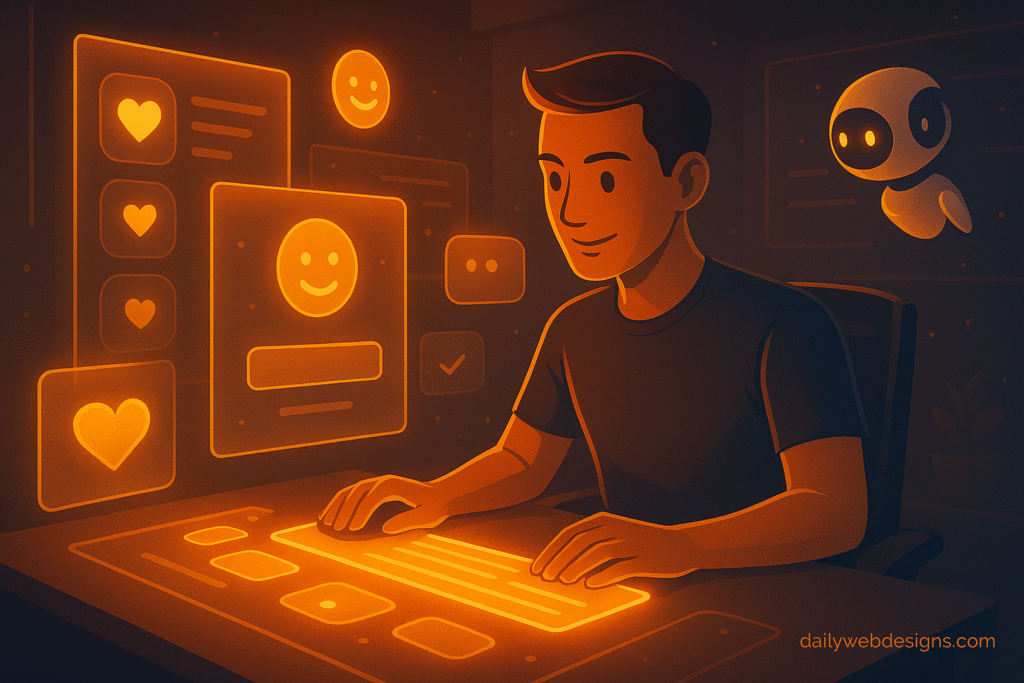Introduction: The Rise of AI in UI/UX Design
In 2135, after AI took over all design roles, only one human UI/UX designer remained — Mira Rao from Chennai. She wasn’t needed — yet somehow, the top tech company, NeuronCloud, still requested her opinion on every major launch.
Why?
Because Mira designed with emotion, not just efficiency. While AI optimized for clicks, Mira optimized for feeling.
One day, Figma AI presented its latest app redesign — perfect in structure, soulless in experience. Mira paused, added a hand-drawn ripple animation to a login button, and said:
“Make users feel like they touched water, not glass.”
AI has revolutionized UI/UX design. Tools like Figma AI, Adobe Sensei, and Uizard can generate layouts, suggest colors, and even predict user flows — in seconds. Automation has brought speed and efficiency. But one thing AI hasn’t mastered?
Emotion.
No matter how advanced artificial intelligence becomes, emotional UI design — the human ability to create interfaces that connect with people — remains irreplaceable.
What Is Emotional UI Design?
Emotional UI design focuses on creating user interfaces that not only function well but also feel right. It appeals to users’ senses, memories, and moods through elements like:
- Microinteractions (e.g., haptic feedback or button animations)
- Color psychology
- Copy that feels conversational, not robotic
- Visual storytelling
These subtle cues make an app or website memorable — and that’s what builds brand loyalty.
Why AI Still Lacks Human Sensibility
AI is great at mimicking patterns. But emotion? That’s not data — it’s intuition. For example:
AI can recommend the best layout for usability.
But only a human can design a landing page that makes a user smile.
Emotional UI design comes from empathy — something that requires personal experience, culture, mood, and intent. It can’t be fully replicated by algorithms.
The Power of Human Touch in a Digital World
Imagine a fitness app designed entirely by AI. It might be functional, sleek, and efficient. But now compare that to an app where:
The “Well Done!” message after a workout feels like a hug
The UI changes color with your mood or weather
Animations celebrate your progress with small delightful gestures
These emotional moments aren’t necessary for function — but they’re crucial for connection. And only human designers truly understand that.
How to Combine AI + Emotion in Your UI Design Workflow
AI isn’t the enemy of emotional design — it’s a tool. Here’s how you can integrate both:
Let AI handle the repetitive layout tasks
Speed up wireframing, component creation, and variant testing.Use your creativity for emotional layering
Add emotional touches: animations, tone of voice, storytelling.Test with real users, not just data
Empathy comes from conversations, not spreadsheets.Personalize where it matters
Use AI to gather insights, then humanize the experience.
Conclusion: The Future Is Human-Centric AI Design
As UI/UX design moves into a future filled with automation, designers shouldn’t compete with AI — they should complement it. Let AI do the heavy lifting, but keep your focus on the heart of the experience.
Because users don’t just want things that work.
They want things that feel right.
✨ Bonus Tip
Add personality to your designs with thoughtful copy, surprise animations, or subtle sound effects. These little touches go a long way — and they’re uniquely you.
